The Highs and Lows of Game Design

Howdy, Boz here, the game designer, programmer, project lead, etc for Twilight Tower.
According to the calendar it’s been about 5 months since I last sent out an update, so it’s just about time for another. I’ve been working on Twilight Tower every single day since then (with a few days vacation in July), so it’s felt more like 5 weeks since last we spoke.
The initial hype for the jam version of Twilight Tower has calmed down these days, but in it’s prime, it was featured by websites such as Itch.io and Alpha Beta Gamer and several people have sent me messages to profess their excitement for the game. You can play it here: https://boz-float.itch.io/twilight-tower
The Story
You’re starving to death. A stranger is about to fall to their death. Help them? Leave them and take their supplies? Stomp on their hands?
Twilight Tower is about exploring an otherworldly prison that inexorably saps the energy, hope, and morals of all who are condemned for eternity. You play a prisoner exiled to this otherworldly dungeon with an infinite pit in the center, desperately climbing to escape sand seeping up through the floors. And failing, forced to try again each day.
It’s a dark decision-making, non-battler card game where morality conflicts with survival. The primary narrative theme is desperation. It’s about making a decision between bad and worse.
The story is somewhat of a shared groundhog day prison with otherworldly creatures. Exploring the extremes of those who have been there for an unknown/incalculably long time through the lens of a newcomer.
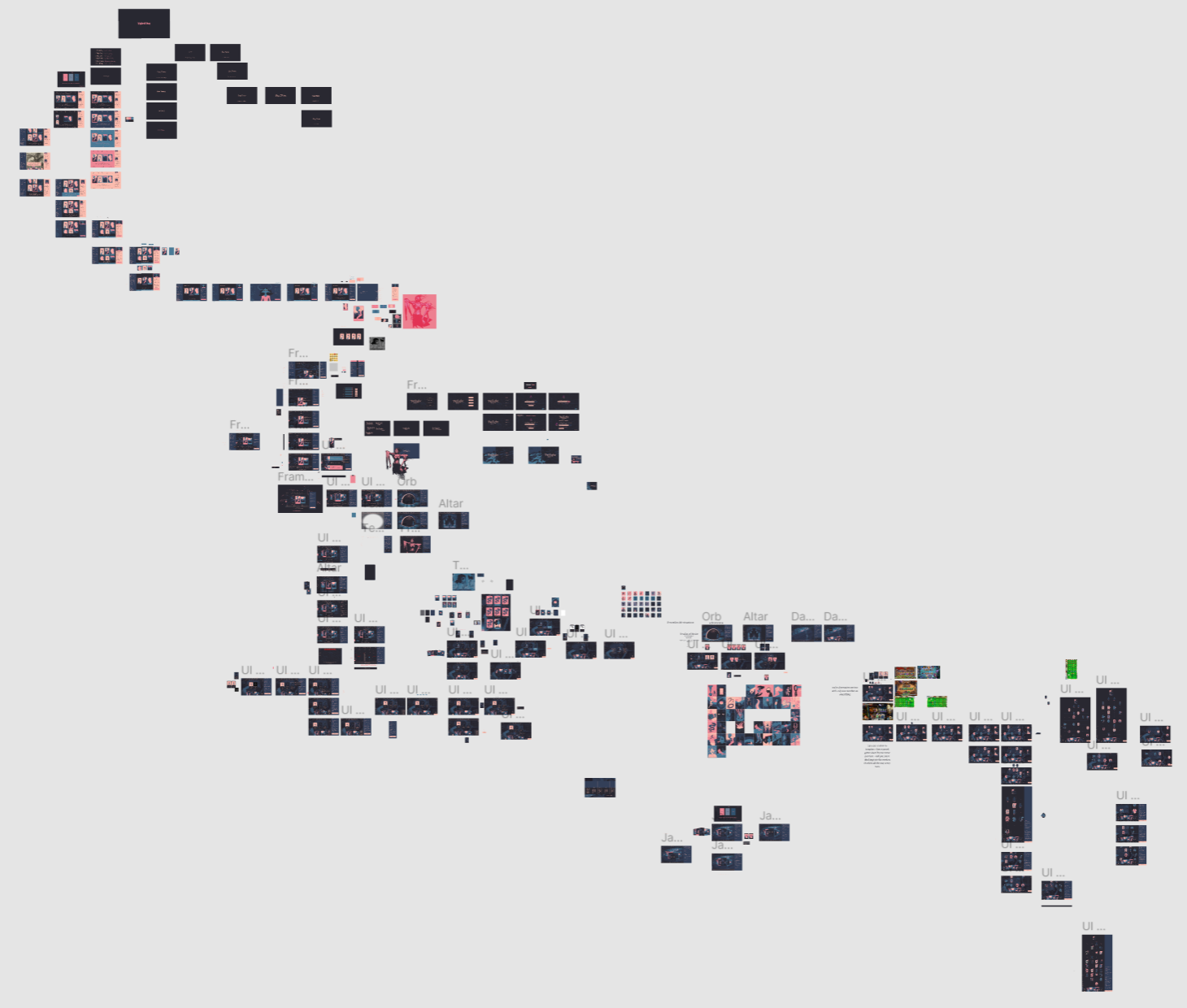
What This Update Is
I tossed around a few ideas about what sort of update to write about Twilight Tower, but I think it makes the most sense to just speak to where my head has been recently: game design. So what is written below is somewhat of a case study on game design and process.
Also, I should apologize for being such a wordy person, as you may have already noticed. Maybe if I updated more often I could be more terse.
Knowing what you’re supposed to do, but not realizing this is the time to do it
This is a story that hopefully shows how easily you might miss an opportunity to test your ideas even faster. There’s a difference between knowing what you SHOULD do and knowing when/where/how to do it. What I’ve written about below is about game design, but you can apply that thought to anything. Learn from your mistakes quicker. Expect mistakes, or rather, expect not to be completely satisfied and get your unsatisfying work done as quickly as you can so the real work can begin.

Where the Design Started
Twilight Tower began as a color palette assigned by a Society of Play (game dev group) game jam: https://lospec.com/palette-list/twilight-5
And then a melancholy guitar riff: Twilight Tower - Climbing by Haberworks
While looking at pictures of sunset. I wanted to capture the feeling of dread associated with the twilight hours as they indicate the coming of night and therefore danger.
Then the feeling of being pursued came up. Then the idea of trapped in some stone prison. Then the idea of rising sands came about. This came along with the concept of choosing cards that represent branches in your path, but come with risks and rewards. The idea was to represent your morality slowly being consumed as you ran out of resources and the sand approached.
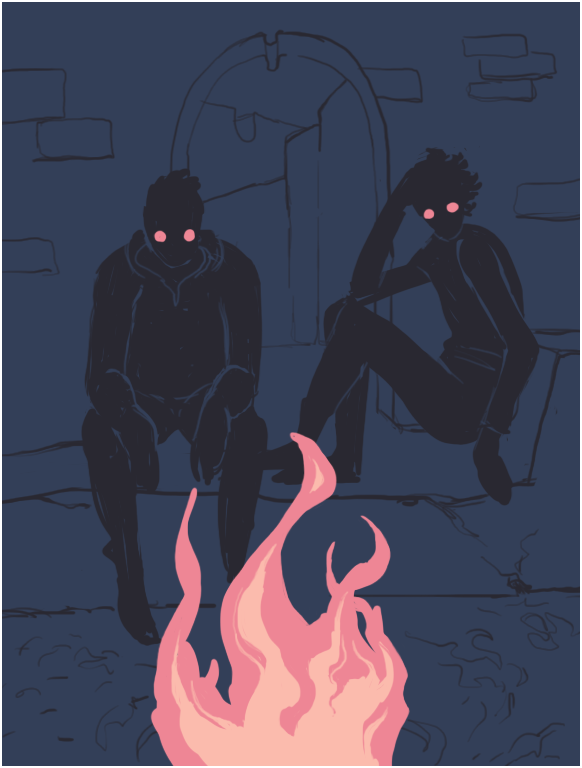
The more you gave up turns helping others, the more outside help cards were added to your deck. The more you took short-term options to save time, the slippery slope of worse cards began to enter your deck. Both were viable.
Not many players of the jam version know this, but if you max out your distrust, Friend will confront you and you can either spend valuable time working out your differences, or you can kill them and take their boots, which improve your odds of survival, but at the expense of your guilt and options.
The Problem With The Jam Version
Although people were getting into the story, the world-building, the questionable morals, the mood, and all that, they weren’t coming back to play. To me, that indicated a need for better game mechanics.

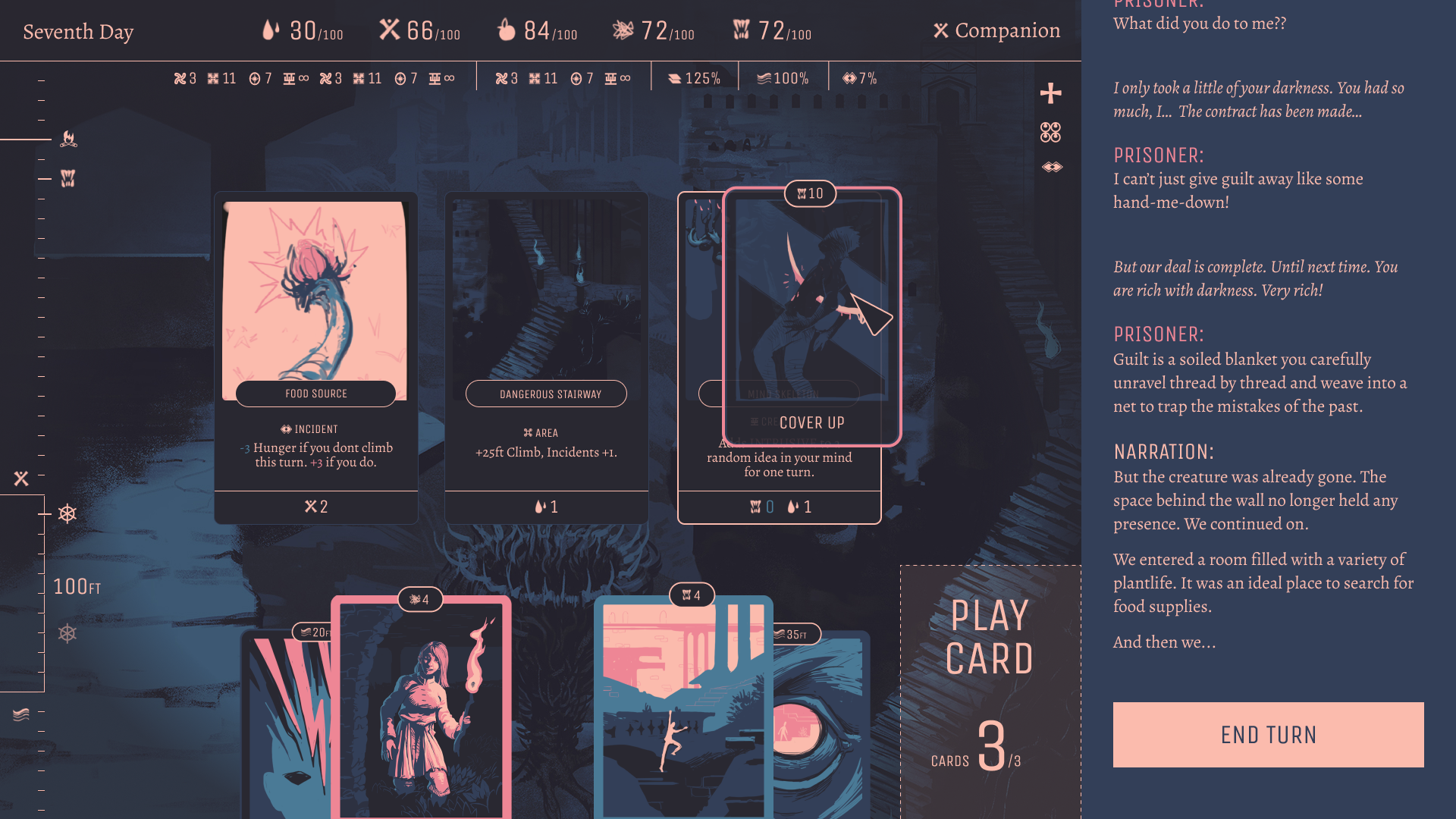
One problem with the jam mechanic was that there was no point to ever not choose the climb card. Also that you just did whatever messed up your stats the least. In the jam this was intentional - it was meant to be a quick experience showing how when shit really hits the fan, morals start to decline. However, I needed to find a way to make this work on a larger scale game, without making a set of custom cards for every single turn.
I started coming up with all sorts of mechanics to scramble up “ideal” play, to keep the challenges engaging. Each turn, you would be greeted with compounding situations that would prevent you from playing the best combos in your hand and instead play in a more reaction-based style.
Some cards were about trying to cover your tracks whenever you did something bad. But we soon realized that having the Prisoner have commands that were just straight up murder and theft was too “Jesus vs Hitler” in the mechanics. Not enough grey area for TT’s standards.
Plus we noticed players would avoid all obviously bad moral choices, even to their detriment. Needed to put some noise in the morality signal.

Once I got a solid vision of the new version I wanted to build to solve all the problems of the jam and implemented the basic card game engine code, it was back to testing the card play itself.
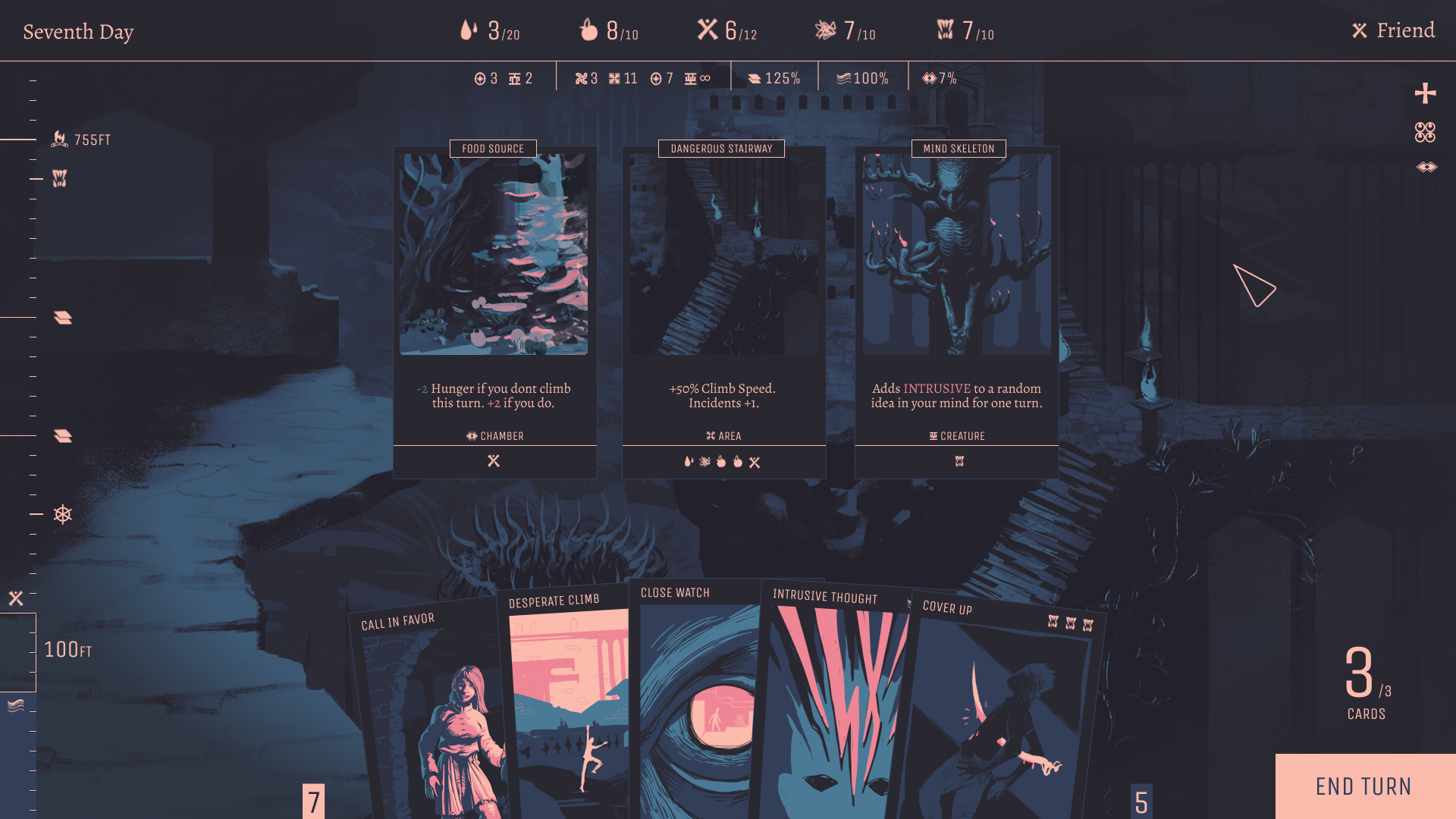
Taking Too Long
After spending all this time programming, I was growing frustrated because I still wasn’t able to test the decks and combos very quickly.
Trying to program various cards to play with was too time consuming to really get a sense of the game in any realistic time-table. How was I going to “quickly” test a deck of 20 card ideas when each card idea was consuming 1-3 hours of implementation and bug fixes?
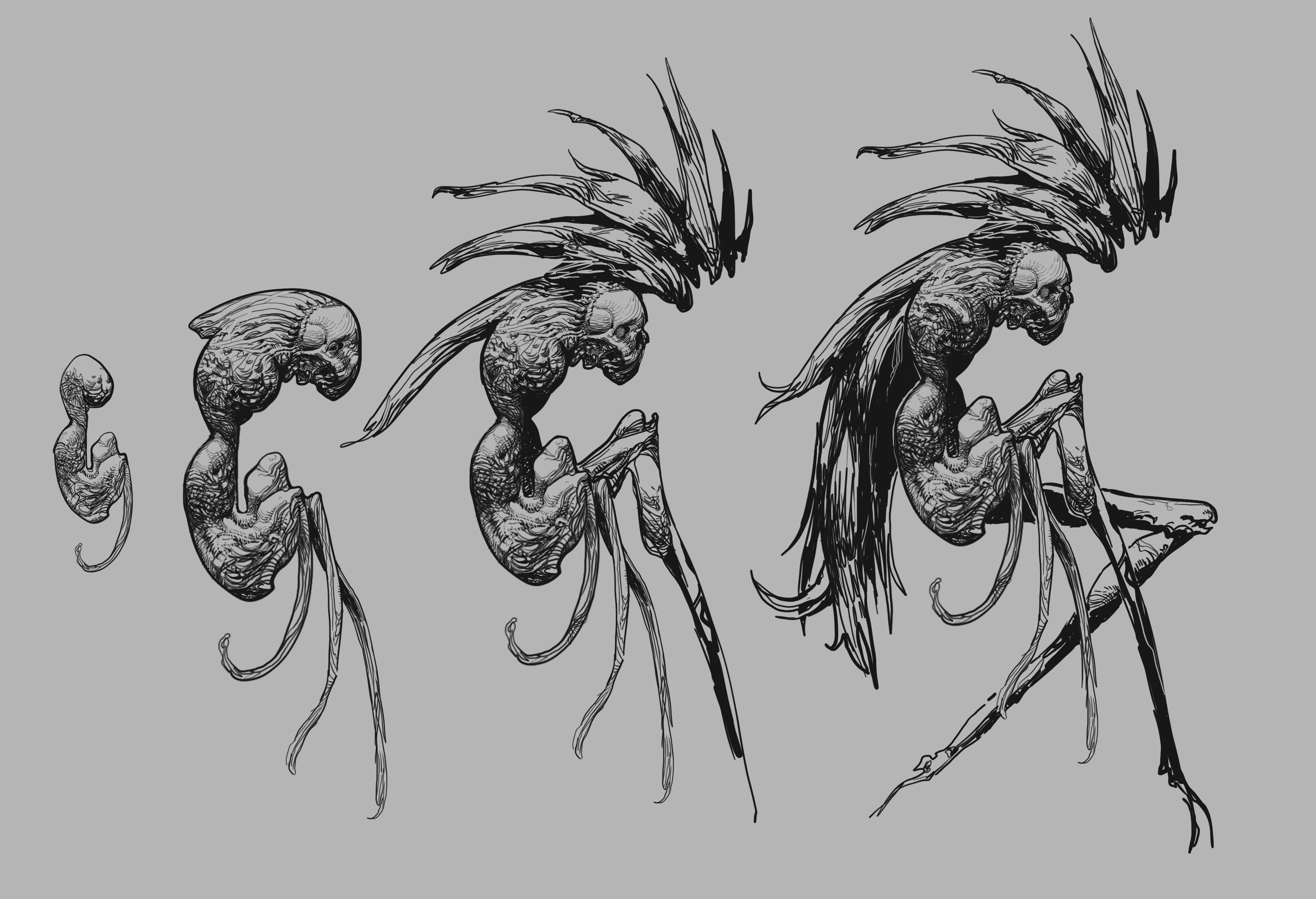
Organic Development
At the same time, I noticed a pattern in a lot of books I was reading about game design.
In my graphic design work I’ve always called it “fumbling in the dark looking for the way”. Well, Sid Meier calls it “Find the fun.” Blizzard North’s team called it “Organic development.” Ken Levine borrowed the startup culture credo: “Fail faster.”
But I think Dan Harmon described it best, it goes something like this: We’re idiots when it comes to creating, but geniuses when it comes to complaining. So make something bad and critique it until it’s good.
Also, I don’t think it’s about failure, per say, it’s about failure recovery. It’s easy to give up after a failure, but the true technique is how you rise up again after failure.
The process looks something like this:
Concept -> Actualization -> Critique -> Revise -> Repeat.

I wanted to test faster but I was stuck in the swamps of development. Everything I wanted to test took FOREVER to create. And it’s not like I was trying to build a fully polished finished product - I was trying to get to testable as soon as possible. How could I fail faster? No - faster than that. I think this is a question you have to ask yourself daily in game design “How fast can I test this? Can I test this faster at acceptable loss of fidelity?”.
Despite knowing I was supposed to fail faster, I mistaken believed I was already doing it. But it wasn’t fast enough. I was programming a system far too slowly to ever get to testing. And what would happen if I needed to adapt what I was programming to something entirely different? This mistake may have cost me a couple months.
So, how do I do this faster?

Failing Faster on Paper
I switched to paper prototypes. An advantage of a card video game is that it doesn’t take much stretch of the imagination to recreate in paper form. In the digital version I’d have to argue with the computer if I wanted to make a change. On paper I could just write a little more on on the card.
I kept putting off paper prototypes because I felt like setting up on paper would be time better spent programming. Wrong, wrong, wrong. Switching to paper prototypes, I could concept, actualize, critique and revise an entire new deck in a single session - something I still hadn’t been able to do in programming since the jam.
What’s a good cliché here? Haste makes waste? Maybe this was just an artifact of being both the game designer and the only programmer - splitting one person into multiple roles.
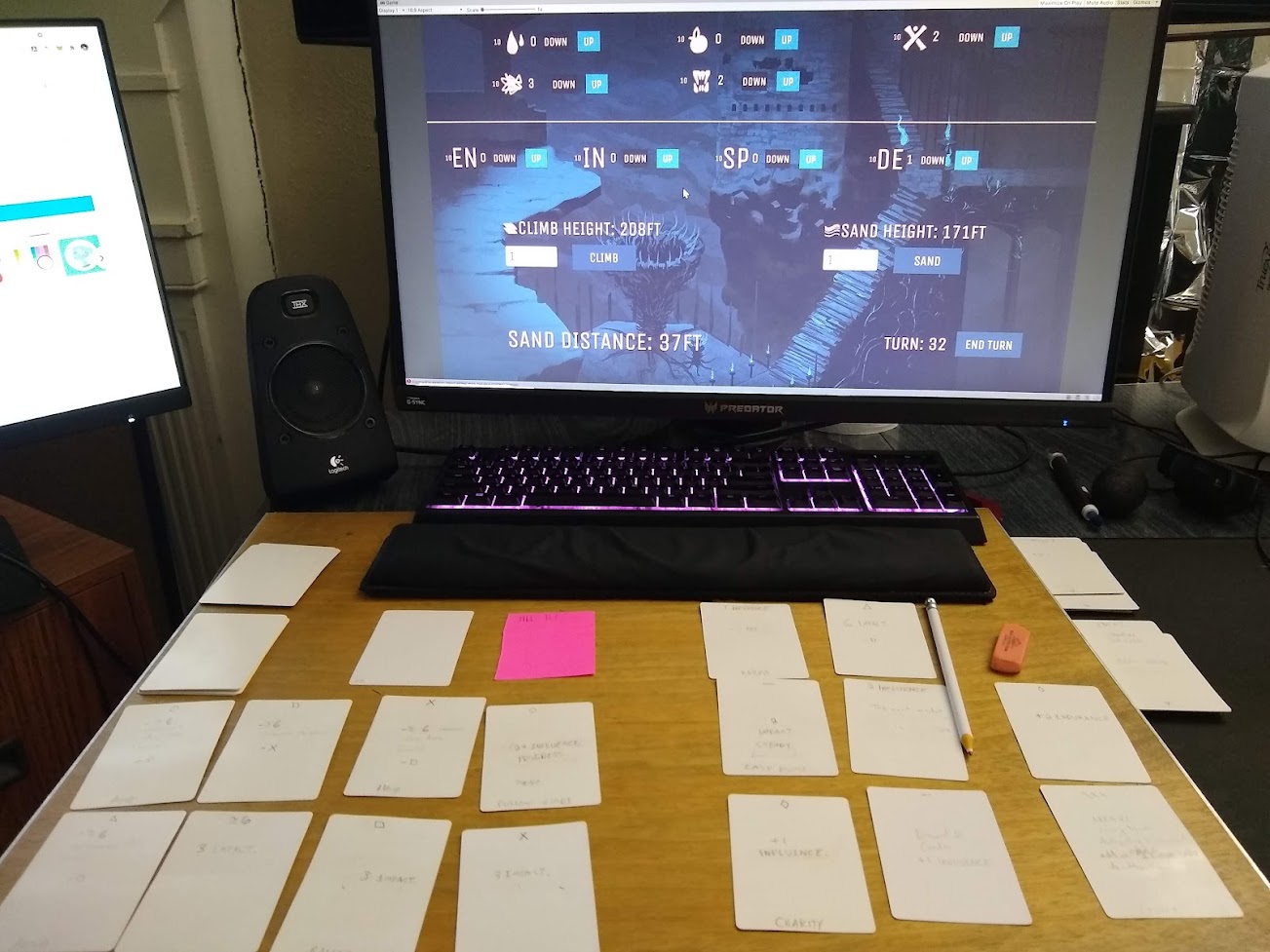
This led to a digital companion to help keep track of variables. For a couple weeks, I’d play through the game, take extensive notes, then make adjustments for another playthrough.
This led to major revisions in the systems. I mocked up what the game would be like if you had these new “challenges” each turn that if you didn’t deal with soon, they would compound and overwhelm you. This might be someone who follows you and undermines your efforts, pest creatures stealing your food, risk/reward scenarios, this or that choices, and obstacles that slow your efforts to escape the sand.
My favorite concept to come out of this was that depending on what challenge you’re solving, the “verb” changes. This game isn’t about fighting monsters, it’s about escaping the sand and overcoming obstacles. So instead of “DAMAGE” or “FIGHT”, the verb for a Mysterious Cave could be “EXPLORE” and an encounter with a denizen of the tower could be “NEGOTIATE”.

Still Not Good Enough
After a couple weeks playing this way, all the over-arching design problems became more clear. The game was fun… but it was becoming more and more generic. It felt like someone had already made this game, multiple times. Every time I tried to make the game feel more reaction-to-situation based, it seemed to pull the game closer to your typical card-battler.
In the jam you were basically trying to increase your chance of getting a climb card to escape the sand while balancing your stats. I started converting this to the amount you climb almost as though you were dealing damage to one big enemy whose HP bar was “distance to the safe zone”. Some combos were about climbing higher for less cost.
One of the unique mechanics from the original jam were the negative stats: Exhaustion, Hunger, Guilt, Distrust, and Danger. The stats all referred to some negative state piling up on The Prisoner as he progressed towards the next safe zone. The idea was to feel like you’re bruised, battered, and past your limit dragging yourself to the safe zone as the deadly sand nipped at your ankles.
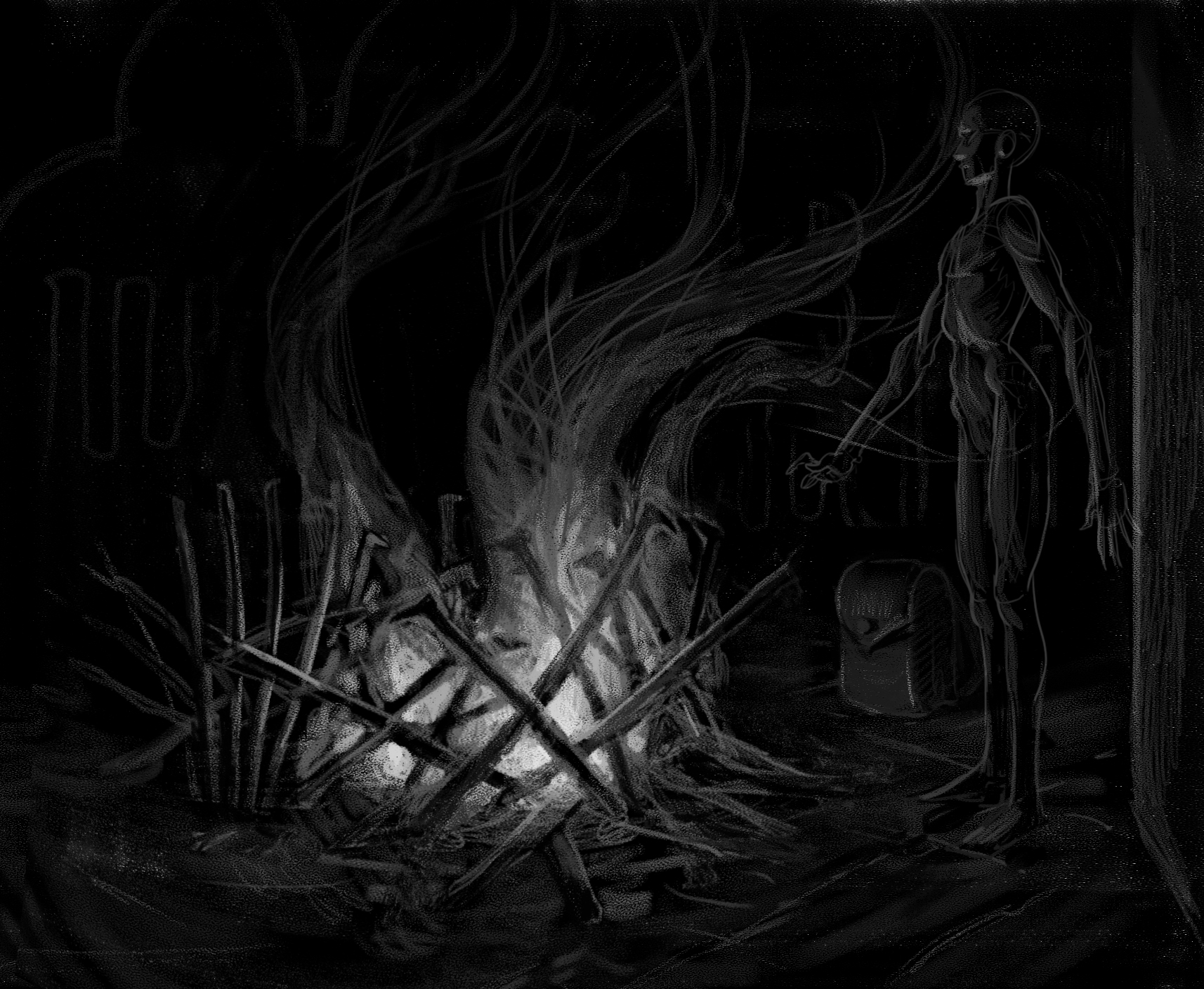
The problem was, because each card cost one of the stats, the gameplay devolved to merely balancing the stats. Which seemed really cool at first, but it led to a lack of focus in deck-building - it was less about combos and more about keeping stats low. The way I would lose in the paper prototypes was when I ran out of stats. It was basically like having five mana bars. In subsequent plays, I would focus on not playing expensive cards. Which felt like it defeated what I love most about deck-building games - using the most opportune cards as soon as they are drawn. So… why not just go back to the single cost pool?
In the jam, narrative linked into the gameplay with every action, and now there wasn’t any room on the screen to show that. I originally removed it because if each card said the same thing every time they were played, then the text became ignorable. The narrative was peeling away.

After all that time prototyping, I realized I had played a far better version of this game before, it’s called Slay the Spire.
In trying to convert the jam version of Twilight Tower into a “fuller game” I essentially backed myself into a corner where every problem I “solved” pushed me one step closer towards creating a “Twilight Tower themed” Slay the Spire.
Shit.

The Game Designer’s Trough of Despair
I needed to back up and think. Twilight Tower needed a more unique base mechanic. We love the narrative and the lore of the world, but a strong mechanic needs to pair with it.
I presented my progress and conundrum to the Society of Play, an indie dev community that does weekly meetings on Discord. There were a lot of good suggestions, including “Play Slay the Spire and write down what you don’t like about it”. Critique something? Humans are geniuses at that!
At the time, I was reading the book “Board Game Design Advice”. In it, several designers mentioned how they play other games to collect their thoughts when they feel stuck. That sounded like a good excuse to play a lot of other games. So I took some time to play and research several different games.
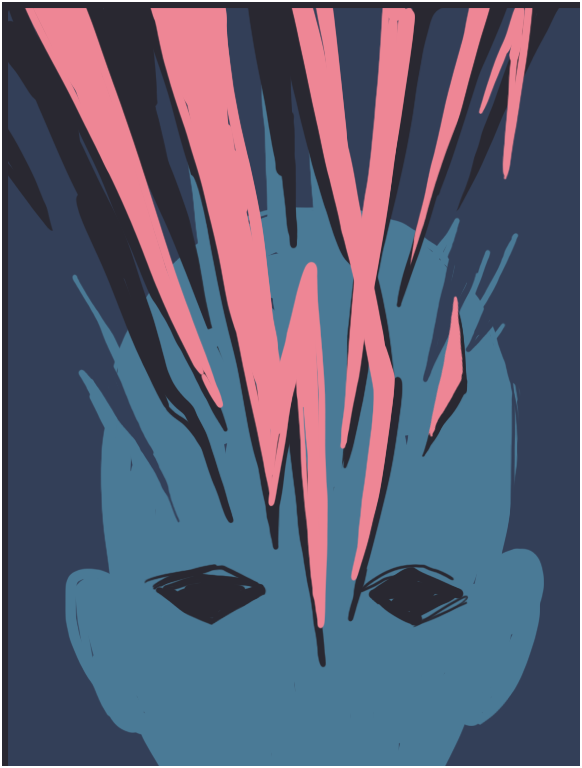
This coupled with my strange process of daily writing and thinking, where the thoughts bleed into all aspects of life and every idea somehow boomerangs back into the project. Running to write something down while doing the dishes or showering, playing confusing surreal games in my dreams, and spending time actively brainstorming and sketching new angles on the problem.
I realized that I had spend the last couple months exploring what makes deckbuilding games fun and ways to design fun decks and combos. Confident that I could do at least that much, I looked for a design base that would lead to it’s own solutions, and not retread the exact same ground as other games.

What appeals to me about Deck-based abilities
I’m a huge JRPG fan. I was flipping through the Nintendo Power Final Fantasy 1 Strategy Guide before elementary school. JRPG abilities were the mana costs and resource rationing. It got too repetitive. I always felt like the “Fight” command should just be removed. The ideal strategy was almost always to save your best stuff for the boss and spam “fight” until then. It’d be cool if you could just always use some sort of interesting ability.
Another big innovation that caught my eye was ability cooldowns. You don’t always have a “fight” command, but you can’t spam your best attack either, not while it’s on cooldown. What always bothered me about cooldowns was that you almost always want to use it immediately - early and often. I would end up just spamming the button waiting for it to come back up, or watch the timer. (By the way, after asking around, I think the earliest cooldown ability was in StarCraft or Warcraft 3?)
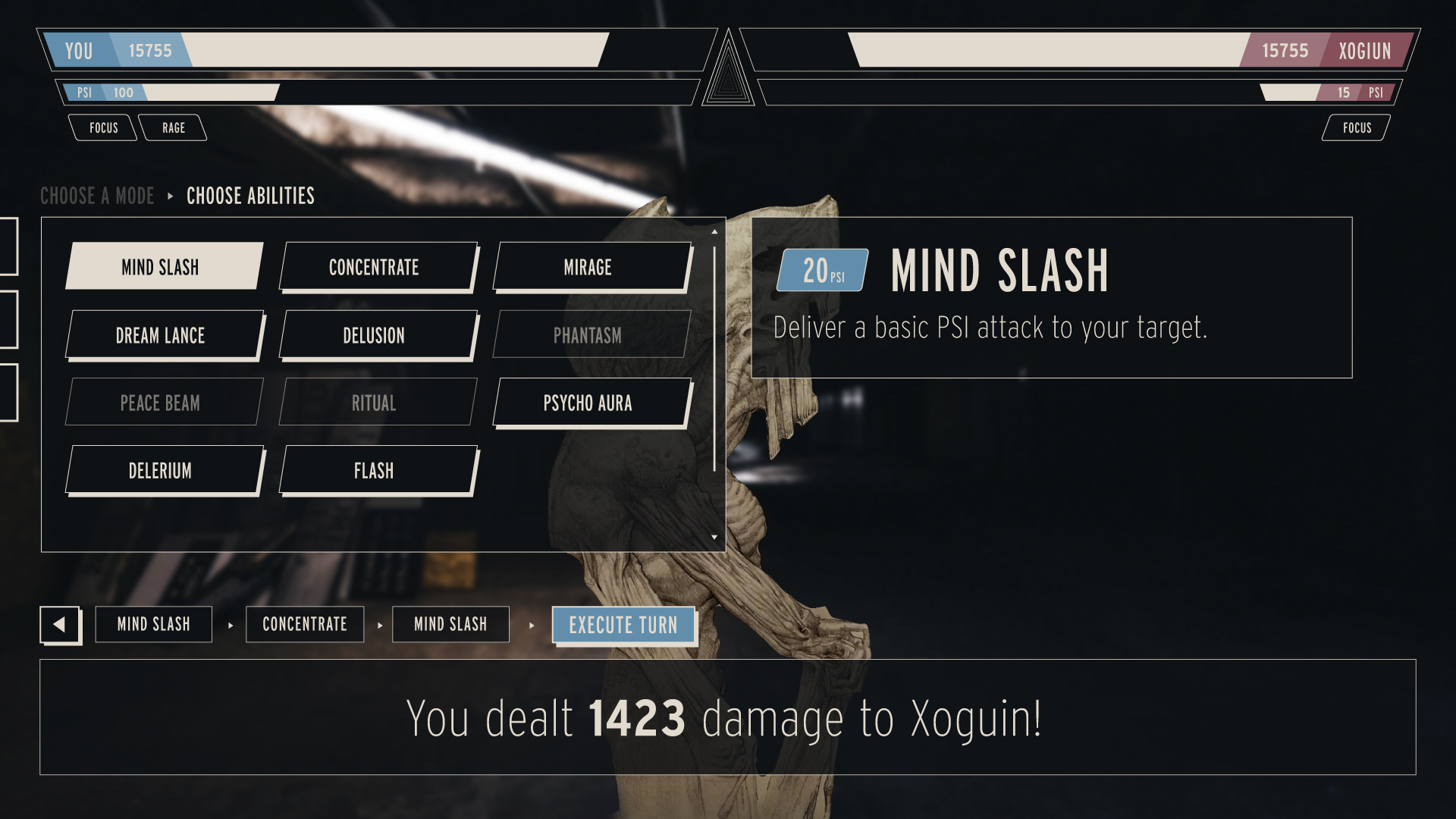
Then there’s the deck-based ability. I see this as a new form of cooldowns. Games like Slay the Spire brought the random deck draw and combinations. That too, could get repetitive if it wasn’t for the roguelike nature - you have to start over and you don’t know what you will face or what abilities you’ll gain. But the thing is, you’re free to use whatever you best abilities are, provided you draw them and they combo with your situation best.
Law of Familiarity
When creating something I follow what I call “The Law of Familiarity”. Which is based on Raymond Loewy’s MAYA Principle (Most Advanced, Yet Acceptable). Essentially, bridging the gaps between what people are comfortable with and something new. Don’t scare folks with too much new, essentially.
In this same thought-process, while playing games for inspiration, I started to distill the core of creations down to their combination of other works/genres. These aren’t perfect distillations, just a sense of things.
A few top-of-mind examples:
- Starting with a non-game: Star Wars combined westerns and Flash Gordon.
- DnD combined war games, roleplay, and Lord of the Rings.
- Warcraft basically took the obscure Dune II and expanded on it with their understanding of audience appeal.
- Diablo combined rogue with real time and isometric graphics.
- The first JRPGs combined set DnD campaigns with streamlined controller video gaming.
- Slay the Spire combined the deck-building of Dominion with JRPG battle and the UX of Hearthstone.
- Griftlands combined deck-building mechanics with narrative.
- Monster Train combined deck-building mechanics and Tower Defense.
- One Step From Eden combined deck-building and Mega Man Battle Network.
What was I combining deck-building with? Narrative? Griftlands was already doing that and I really didn’t want to retread their path. Here’s a few game design concepts I really liked that came up in that time period:
- Roguelike Disco Elysium where you go insane as you die every day, with some Griftlands influence.
- A game to match the feeling and pace of the movie Good Time where you are a charismatic liar and you are constantly getting into worse and worse situations as you try to stack your lies on top of lies (back pocket for later).
- A reverse Plants vs Zombies where you try to piece together your memory of your attempts to climb the Twilight Tower. (The thought here was that the tower is defending from your efforts to traverse it)
- A more procedurally generated version of the jam game where you are thrown into these “Lego block” situations and you have a deck of narrative cards that you play to get yourself through them (mostly) in one piece and to your advantage.
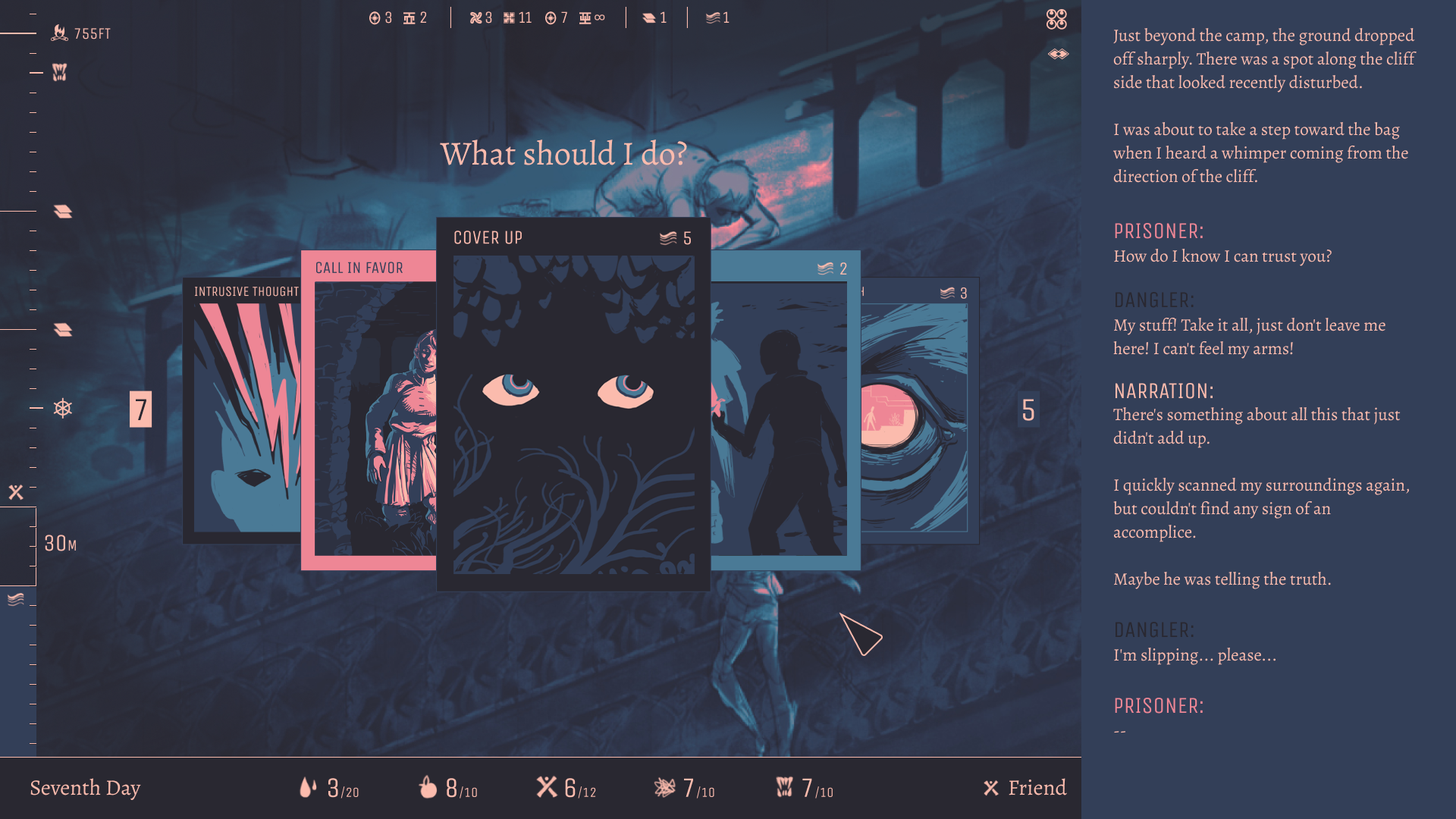

I started prototyping some new concepts and presenting them to the team. These concepts were starting to be fun, really fun. Ultimately, I was looking for a design that would have an innovative base that could design itself. This was starting to be it.
The problem with following in another game’s footsteps is that they’ve already solved most of the problems you’re bound to encounter. It’s been tried and done before. In a way you’re sifting through their cutting room floor realizing why those things got cut.
But, if you find an innovative base mechanic, every solution you come up with is only something you could come up with because you invented the problem to begin with.

Something was still off, however. The game was becoming super fun, but it seemed to be losing it’s roots in the narrative and original core concepts. It was getting way too abstract, which I wasn’t super afraid of, but still, what if there was something that matched the concept better?
The Epiphany
Then I got to thinking… what if you were going UP and instead of placing “units” representing your stories? What if your only units were The Prisoner and a companion, working their way through challenges and encounters on the way to the safe zone?
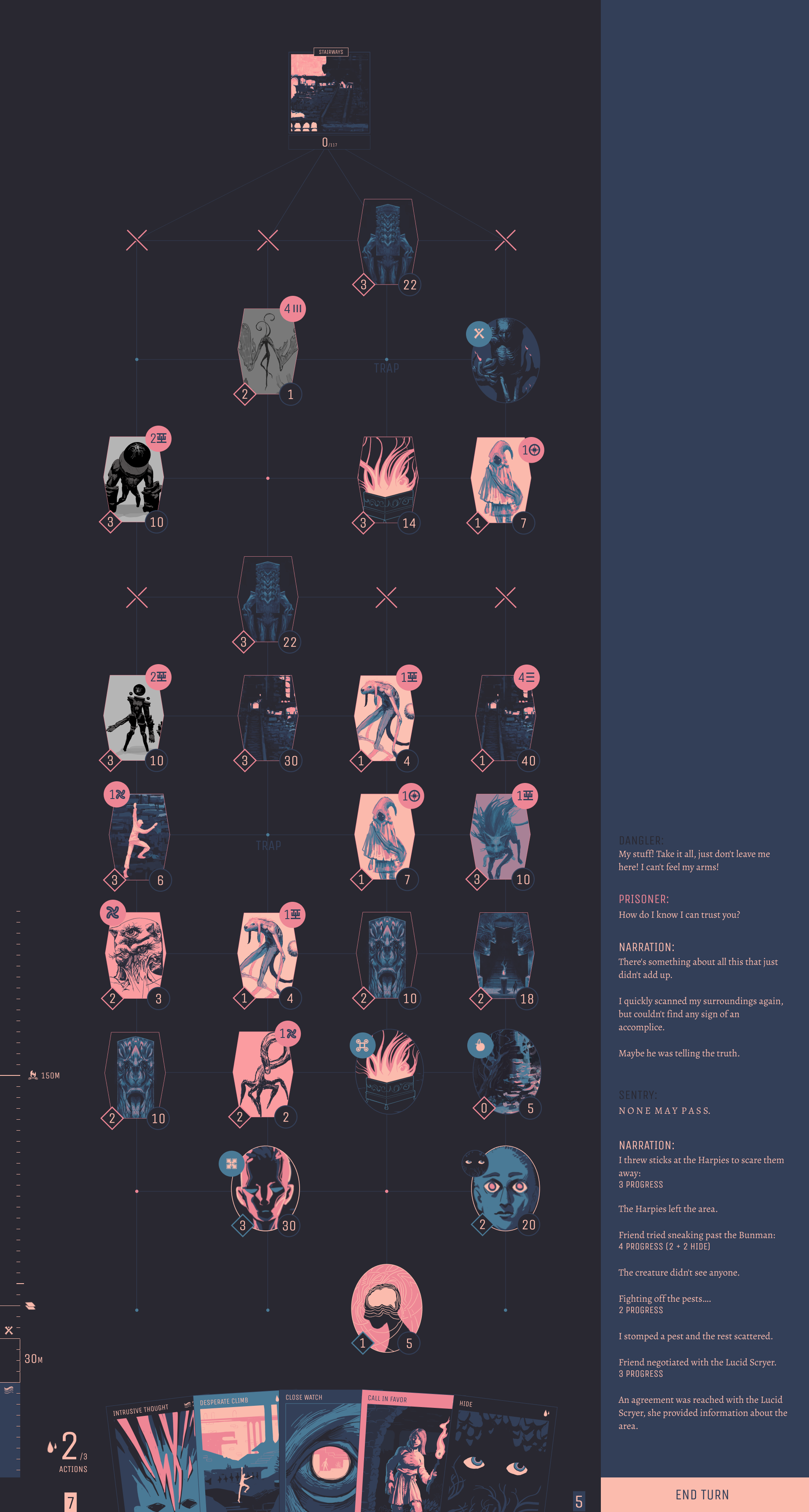
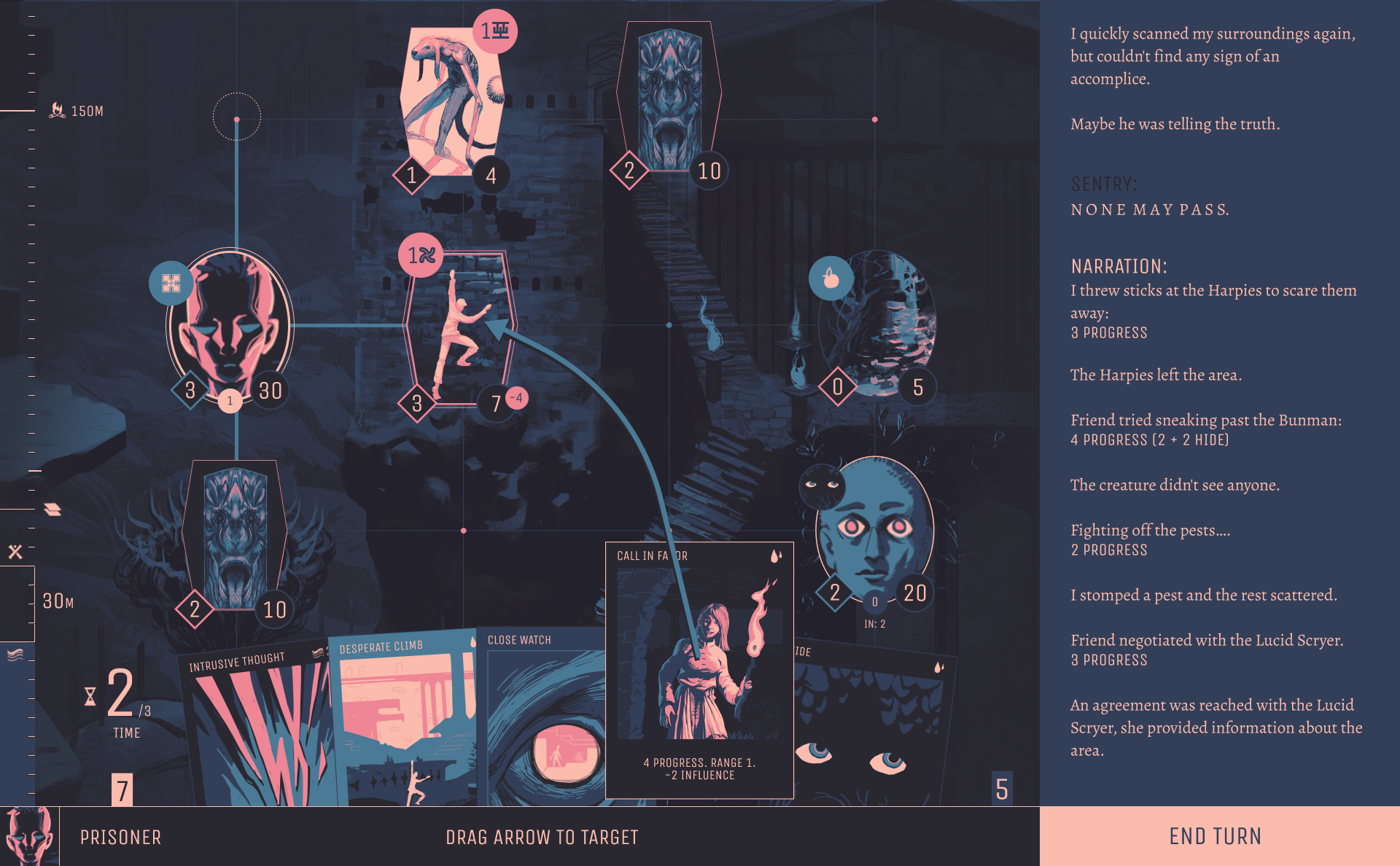
The new design sort of turned into the Twilight Tower Jam combined with Slay the Spire deck-building concepts combined with Final Fantasy Tactics grids. But it also has it’s own thing going on.
So let’s look at the what this design does for our problems:
- The gameplay is unique to the narrative - you have to move up to escape the sand, the tiles are being destroyed behind you and you’re playing in the signature desperate style also found in the narrative.
- The scenario is still a story of The Prisoner’s tribulations through the tower, and may be able to include some conversations mid-stride.
- Climbing is a mechanic, but not a card, and not something you feel FORCED to do the second you get a chance. You can always do it, but also think about how that affects your positioning.
- The narrative panel is back!
- There is a sense of exploration as you move up through the tower. As you explore caves, overcome obstacles, gather information from npcs, and avoid dangerous creatures, you find goodies along the way.
- The verb system from awhile back now works even better because playing a card specifically has a narrative text to go with it that doesn’t have to be a whole story but rather just specifically say “I negotiated with the Lucid Scryer”.
- Tactics games are super fun, and combining it with deck-based ability mechanics is not common in games… yet. So far I’ve only found one other deck-building game that uses a turn-based tactics layout.
What’s next?
After a couple weeks playing paper prototypes, I landed on a super fun base design. Once it was starting to get too difficult to keep up with all the variables and elements and calculations by hand, it was time to move to development. I’m excited to play a version where a computer is handling all the calculations. I’ve been building that version for 3+ weeks now.
Once that’s in a good place, it’s time for people testing. Then all that other stuff like content, polish, advanced UX, meta game design, accessibility, settings, etc.
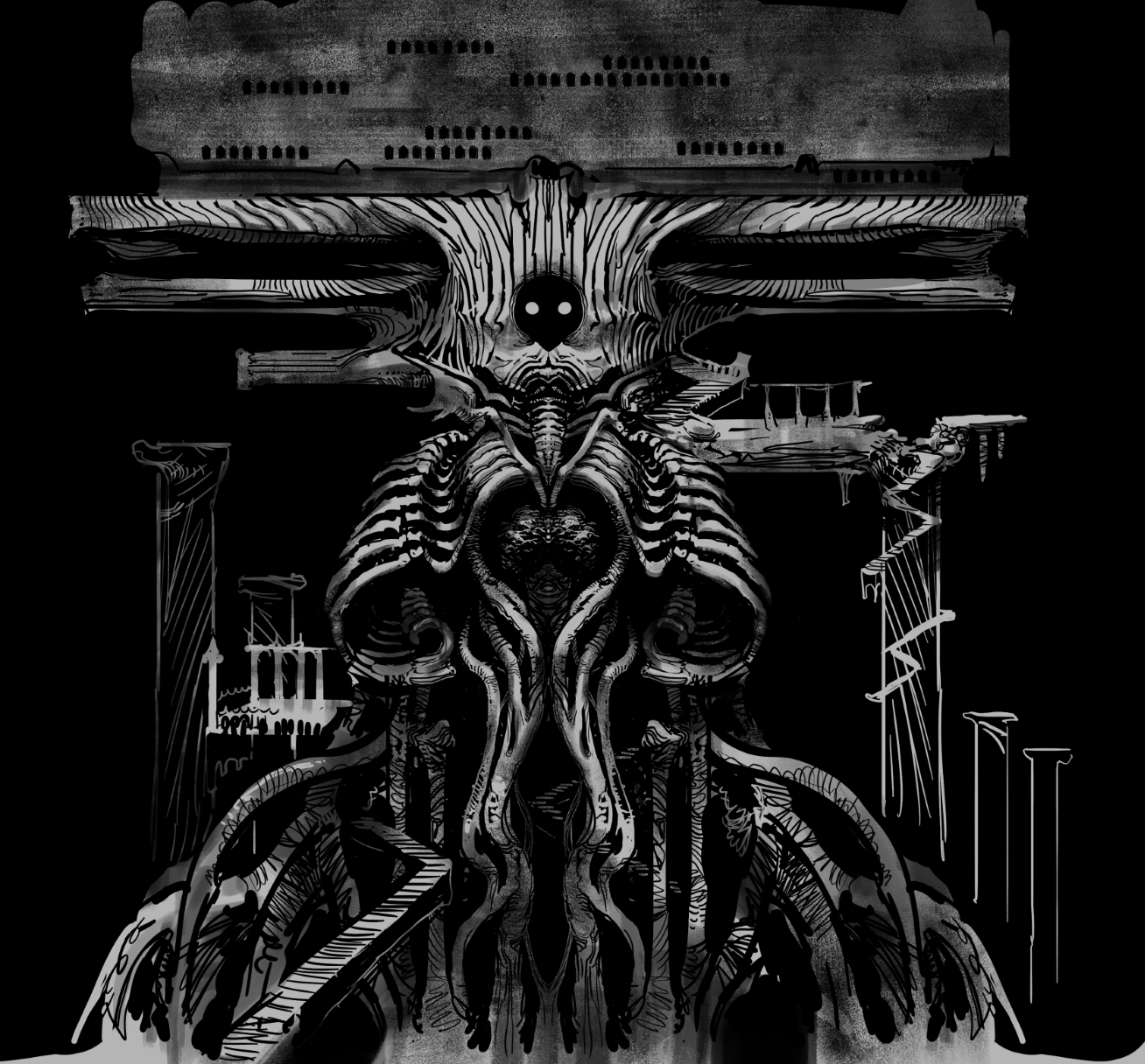
And yeah, I could be testing the paper prototypes with people before starting programming, and that’s exactly what I would be doing if there was a programmer building the digital prototype while I continue to improve the design, but there isn’t, so I’m not. Plus the idea of convincing people to come let me explain to them a nascent game while I stand over them for 3+ hours asking them to bear with me while I write down all the calculations doesn’t appeal to me.
Also what’s next: The narrative! We’ve been doing world-building non-stop since the jam and have a ton of great concept art, story beats, one-off stories, and concepts for dialogue mechanics. This is the area where the others on the team are focused and I just step in for creative direction and mechanics advice.
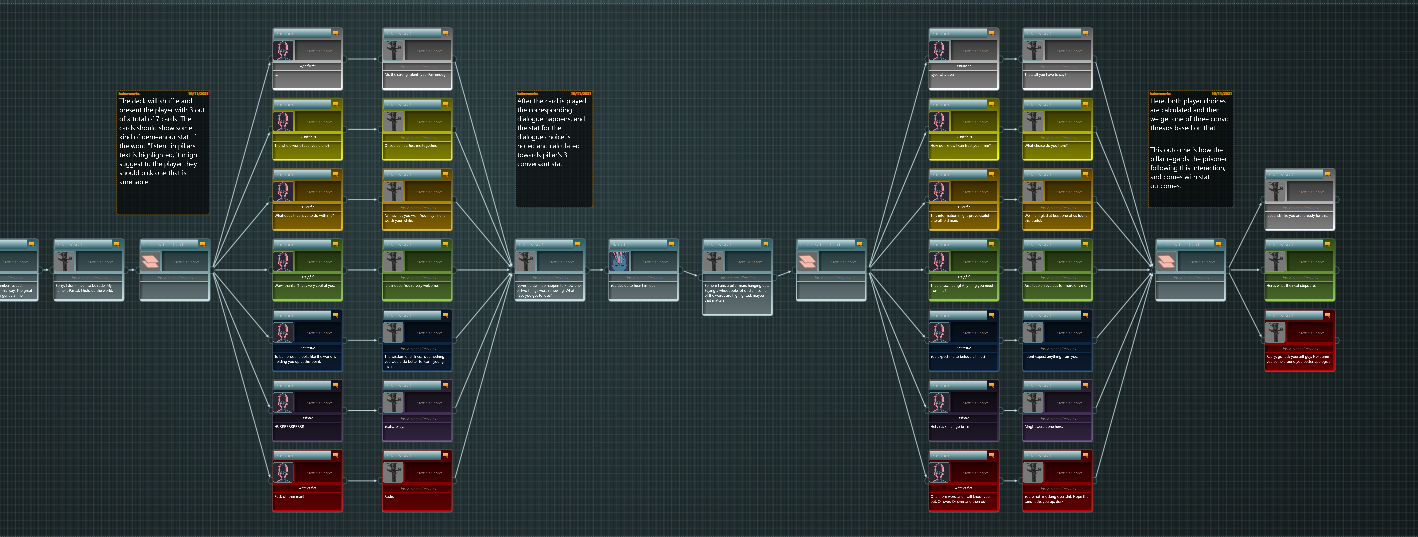
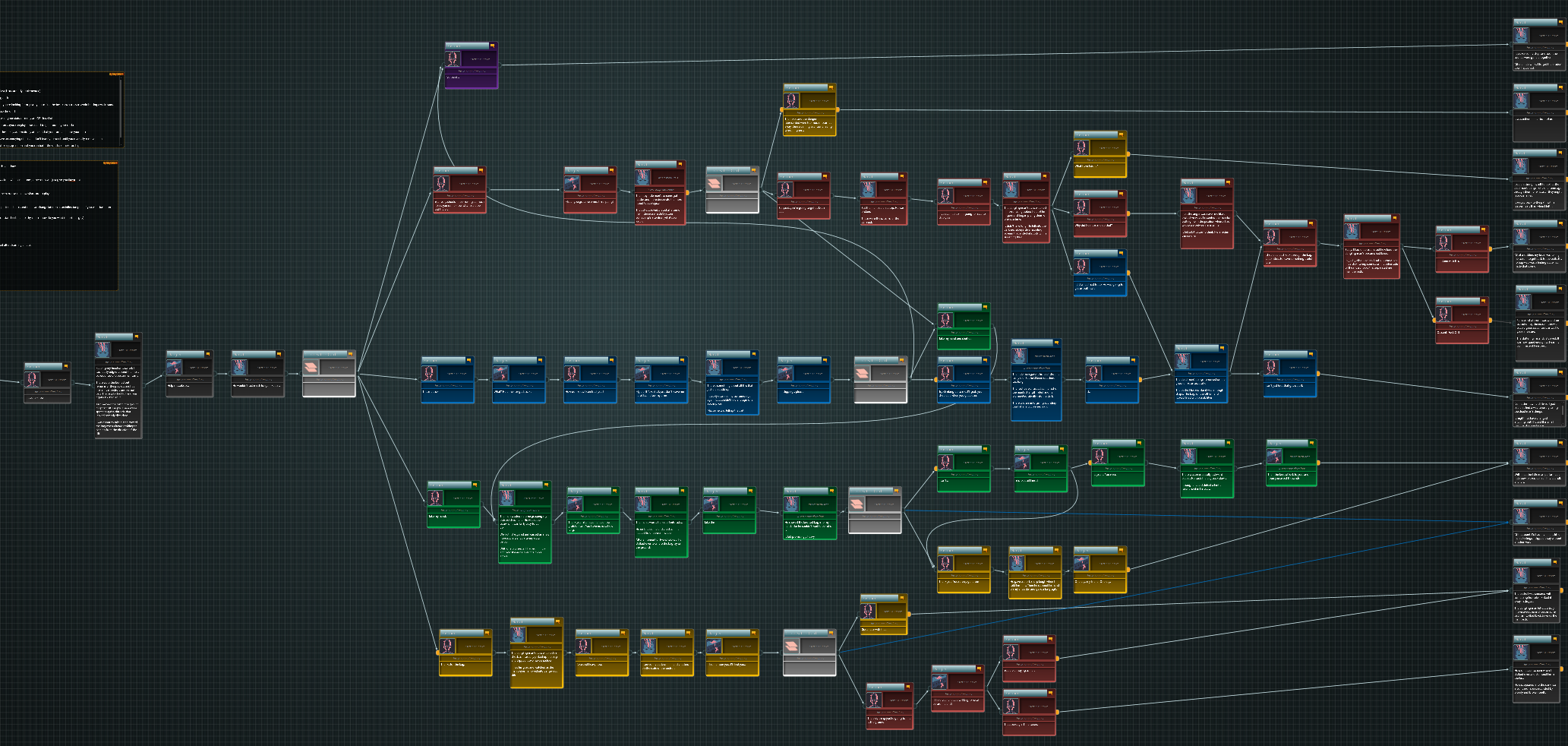
The main conversation mechanic we’re experimenting with right now is dispositions. During conversation you try to get a read on the person you’re talking to and play a disposition card that sets the tone of how you respond. This has an affect on how characters perceive you, which may help or hinder your outcomes with this character.
Getting these two systems working well together with proper pacing is a primary concern of mine, and will be worked through as we go.
Looking forward to seeing what future progress brings.
---------------
Updates in your Inbox
If you’re reading this via a link and want to be notified of future releases, please signup for the newsletter: https://www.getrevue.co/profile/aesth
Follow these people:
- c0hil does the art: https://www.instagram.com/c0hil/?hl=en
- Haberworks does the sound (and keeps us organized in Articy): https://soundcloud.com/haberworks
- boz wrote this post. follow his dumb tweets: https://twitter.com/huminaboz
Come hang out in the Aesth Discord (that’s my discord channel). Come hang out in the Society of Play Discord.
Get Twilight Tower (post jam version)
Twilight Tower (post jam version)
A survival horror/roguelite/dark decision-making card game hybrid where morality conflicts with survival.
| Status | In development |
| Author | Boz of Aesth |
| Genre | Card Game, Role Playing, Strategy, Survival |
| Tags | Deck Building, Horror, Multiple Endings, Psychological Horror, Roguelite, Survival Horror |
| Languages | English |
More posts
- Towers and TribulationsMay 29, 2022
- What I'm Saying When I Say 'Game Design'May 25, 2022
- 2021/05/22 BugfixMay 22, 2021
- Concept Art & Game Design PlansMay 19, 2021
- 2021/04/30 UpdatesApr 30, 2021
- 2021/04/24 UpdateApr 24, 2021
- 2021/04/23 UpdatesApr 23, 2021
- Twilight Tower Updates & Future PlansApr 04, 2021
- 2021/3/27/UpdatesMar 27, 2021

Comments
Log in with itch.io to leave a comment.
super interesting post, thanks! :) looking forward to seeing the game develop